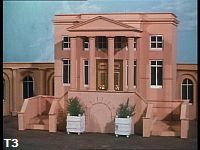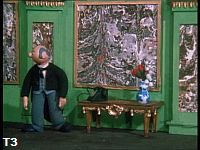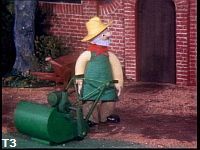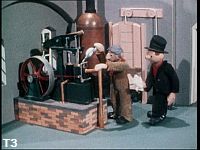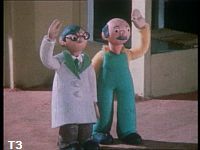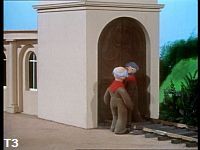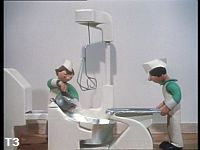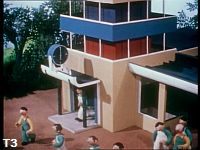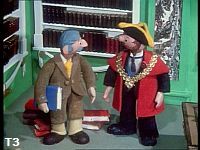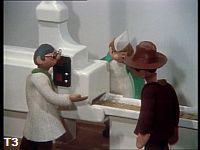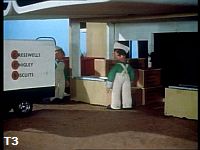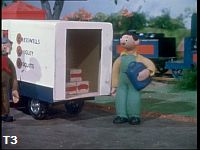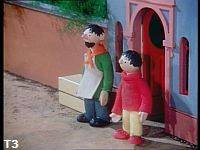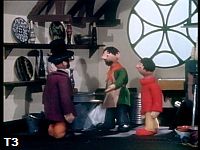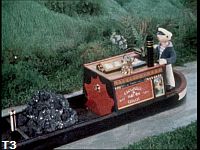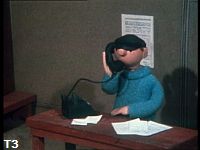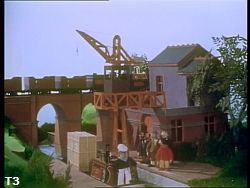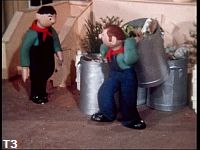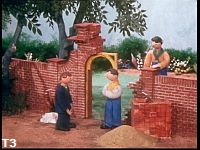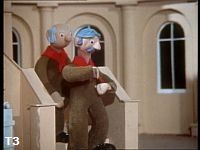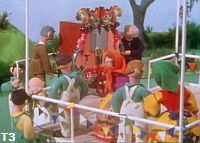 | ||||
Camberwick had its village green and Trumpton its town square.
But Chigley didn't really have a central hub.
The notional heart was Winkstead Hall,the home of Lord Belborough.
And his private steam railway featured heavily.As it linked 2 of the 3 other main locations -Chigley Pottery and Treddles Wharf. But not the 3rd as the line didn't go directly to Cresswells Biscuit Factory.
So,just as every Trumpton episode had a fireman call-out sequence,every Chigley episode had a train journey.
And,to maintain the symmetry,just as every Trumpton episode ended with the fireman's band concert,every Chigley episode ended with a dance.
Next :- The 4 main locations ....
And all the characters tied-in with them
Winkstead Hall
The design of Winkstead was loosely based on Kedleston Hall in Derbyshire.
Owned by the resident Lord of the Manor,Lord Belborough.
But there was no mention of a Lady Belborough or any other family members.
And whilst he did have staff of course,we were only ever introduced to 2 of them ....
With his main on-screen side-kick being his butler.Who was just called Brackett.
And there was also a gardener,called Mr.Bilton.
His private railway meant there was an engine shed just a short walk from the Hall.
And this housed his working steam engine called Bessie.Together with a stationary pump engine called Binnie
And Finally .... the Chigley Oscars go to ?
Well,no surprise that Lord Belborough practically sweeps the board ....
Most memorable character .... Best song .... Best boys toys .... Best voice ....
And even the most distinctive walking style - hands at chest height,elbows pointing out,as per the photo to the right.
Looking like he was about to give a rendition of the famous "Old bamboo" dance scene in Chitty Chitty Bang Bang ( if only ! )
Which was released only a year before Chigley was filmed incidentally.
On this page - a detailed look at Trumptonshire's poor relation, Chigley
Camberwick Green, Trumpton and Chigley
Introductory overview ....
Just like its 2 predecessors,Chigley had 13 episodes. Each one 15 minutes long.
It was first broadcast on BBC 1 in the Watch With Mother lunchtime slot on October 6th,1969
But,due to various scheduling issues,it's initial run wasn't actually over 13 consecutive weeks.
( Details about that are on the "Episode Guides" page.)
Whilst all the initial broadcasts of Camberwick and Trumpton were in black and white,Chigley's debut straddled the changeover to colour.So only the first few weeks were in monochrome.
Although you did need to buy a colour tv set ... and a colour tv license ... and live in an area that was covered by a new colour transmitter to benefit.
All of which meant a slow roll-out for many.
Chigley also had the dubious honour of being the last of the 3 series to have a full re-run on the BBC ( 1986 )
Size-wise,it was the smallest of the 3 locations.
Being little more than a hamlet,in comparison to the town of Trumpton and the village of Camberwick.
And because of the sparser population,a lot of familiar characters from the first 2 series reappeared throughout.
Which also helped to tie all 3 locations together as part of the County of Trumptonshire.
Belborough and Brackett enjoyed a very similar star/straight man relationship to that of the Trumpton Mayor and his town clerk,Mr.Troop.
Bilton was a much more peripheral character.
He only appeared in one episode ( aside from being a passive onlooker in others ).
But he's notable for being the only character in the whole of Trumptonshire to be given a noticeable accent.
Brian Cant normally just used varying degrees of intonation and pitch to differentiate one character from another.
But he drew on his own Suffolk roots to give Bilton a distinct country lilt.Subtle rather than full-blown "yokel" and completely appropriate to the character.But still an unusual departure nonetheless.
Belborough and Brackett were involved in the 3 main stock footage sequences in Chigley :-
No.1 was a well-used ploy to get the storyline running ....
Brackett takes a phone call requesting his Lordship's services in the train.
And he lollops down a long,galleried corridor to either the study or library to pass on the message.
Very much shades of the Captain Flack phone call sequence in Trumpton.
And the garish modern art depicted above the phone and along the corridor was very 1969,when the series was written And probably more than a little inspired by Lord Bath's well-documented artistic endeavours at Longleat House.
No.2 Their 2nd bit of stock footage featured them emerging from the Hall in their overalls,to take the short walk to the engine shed (below) and set off on Bessie.
And No.3 was the actual steam journey itself.
Although there were a few more variations than the fireman's call-out loop that was used in every Trumpton episode ...
The train configuration was always the same ie.train...tender...and 3 seated wagons,which also doubled as freight wagons -even being used for a loose load of coal during the Binnie & Bessie episode.
Brackett always accompanied him on the footplate -presumably to shovel the coal, although he was never actually shown doing it.
And,as with Winkstead Hall's artwork,the idea of using a stately home railway was almost certainly pinched from Longleat, who started theirs in 1965.
Cresswell's Biscuit Factory ( Pics below )
Pic 1 :- The factory,reflecting real world architecture of the late 60's.Despite actually being in the grounds of the old Hall.
Pic 2 :- Mr.Cresswell was the hands-on owner in his white coat. His green dungaree'd number 2 was Mr.Fletcher.
Pic 3 :- shows one of the workers -Willie Munn,who was the nephew of Camberwick greengrocer,Mr.Clamp,and featured in his own eponymous episode.
Below .... The Biscuit Factory features at the end of every Chigley episode ....
The clock above the biscuit factory entrance hits 6 o'clock and the whistle sounds.
All the workers take the short walk to an open air dance hosted by Lord B. in the grounds of Winkstead Hall.With music provided by his Dutch organ.
Echoing the fireman's band concert that ended every Trumpton episode.
But also the notion fostered in Camberwick by Windy Miller and Farmer Bell that the old ways could live happily side-by-side with the new.
Pics below .... The main look inside the factory is during the episode called "Bessie to the Rescue".
Some nice gleaming white machinery that ... shells the eggs ... mixes ... shapes ... bakes ... and packs.
With the boxes emerging out at the loading bay,and into the waiting CCB vans for delivery.
2 Cresswell conundrums to ponder ....
No.1 The name "Cresswells" ....
A mash-up of Crosse & Blackwell ?
No.2 No female workers were ever shown at Cresswell's. But the 6 o'clock dance was for factory employees.
So .... who were the 2 ladies dancing ? Oh,and there's a fashion critique of their outfits further down the page !
Chigley Pottery ( Pics below )
Chigley Pottery was owned and run by Harry Farthing,who was both a ceramics potter and stone sculptor and had a suitably bohemian beard.
His daughter Winnie was also featured regularly,took a lot of trips on the train and was the only child that we saw who lived in Chigley.
No sign of a Mrs Farthing,and I'm certain she was never mentioned either.
Unfortunately,like most of the Chigley residents,Harry was less than memorable quite frankly.
Although Winnie seems to have struck much more of a chord.
Presumably because of her appearance and the very well-spoken voice Brian Cant gave her.
Only one interior room was ever shown -the studio above the front door with the big round window. 3rd pic.
The railway line on the doorstep meant Lord Belborough regularly stopped to do pick-ups and drop-offs in between the Hall and Treddle's Wharf ....
Treddle's Wharf ( Pics below )
Potentially one of the most memorable bits in Chigley,with the convergence of cranes,trains and boats.
But,whilst featuring in most of the episodes,the way it was designed and utilised was pretty underwhelming sadly.
And somewhat symptomatic of the missed opportunity was the crane.
Which was only used very sparingly.And just had an uninspiring box cab with a subdued "whirr" for a winch.
Instead of being centre stage as a high-victorian wrought iron,steam-powered effort with some bright paintwork and lots of puffing and clunking noises.
And the equally non-descript "wharfinger",Mr.Swallow,didn't exactly help to "lift" things either.
With a hatful of bonus points going to anyone who remembers anything about him .... or his song.
Quite apart from knowing what a "wharfinger" actually was and what he was supposed to do.
He was usually to be found up on the viaduct talking to the train occupants,or at the controls of the crane.
Although the 2nd pic,below,shows him in the only interior shot of the Wharf building that we're ever shown.
The river/canal was the exclusive domain of Mr.S.Rumpling,the "bargee",pic 3.
Again somewhat underwhelming unfortunately.
With a barge that just looked nice and went "chug-chug",and no personality or a decent song to compensate.
In fact I'm not sure he'd be that memorable even if he'd towed Lord Belborough on water-skis !
And just a sign that any bit of added interest would've been very well received.
And those were the 4 main locations in Chigley.
The remaining cast
Hardly any actually. And just some very minor characters who weren't tied to any of the main 4 locations
Pic,right :- Mr.Clutterbuck the builder and his 2 brickies Horace and Cyril
They only appeared in "The Garden Wall" episode.
And it was never made clear which one was Horace and which one was Cyril.
Pic below :-
The 2 "corporation dustmen" are widely known as Mr.Gubbins and Mr.Sneed.
But they only appear in the "Lord Belborough's Lucky Day" episode.
And .... those names are never actually mentioned.
With the most we ever get being when one says "me and my mate,Harry".
So they were probably retro-fitted for use in one of the books.
Chigley .... Living in the shadow of Camberwick and Trumpton.
The only time that Chigley really seems to have caught the popular imagination was Lord Belborogh's iconic song "time flies by when I'm the driver of the train".
And if the volume of spin-off merchandise is an accurate gauge of popularity ( which it usually is ) then Chigley was indeed a very poor third of the three Trumptonshire series.
All of which is maybe a little puzzling when you consider that it was basically just more of the same.
But Camberwick & Trumpton had been repeated mercilessly for nigh on 4 years by the time Chigley arrived.
And it was simply unable to provide enough freshness and innovation to combat the almost inevitable Trumptonshire burnout.
Successfully maintaining the continuity,but just too indistinct to make anything like the same impact.
Perhaps not that surprising when you consider the tv law of diminishing returns.
Because if Camberwick was an all time classic,and Trumpton merely confirmation of its genius then Chigley was probably just on a hiding-to-nothing.
A tried-and-tested product.
But ultimately just a victim of its' enviroment ... a bit like an ice cream van in Siberia !
But,ask yourself the following :-
1. Imagine if the other 2 series hadn't been made.
And Chigley was a stand alone show with all the necessary continuity tweeks.
Would it have had the same impact as Camberwick when it came out,and be hailed as a classic now ?
Quite possibly.
2. Or,put another way .... would Windy have been as popular if he'd only appeared in Chigley ?
Or would he have been as popular if he'd only appeared in Camberwick and it been the last of the 3 to air ?
Possibly not.
In short, Chigley was undoubtedly less effective simply because it was the 3rd of 3.
But ....
But there were also some major self-inflicted wounds too because :-
1. The new characters are largely forgettable,with the notable exception of Lord Belborough.
A point driven home whenever one of the Camberwick & Trumpton inhabitants arrive on screen and you suddenly think things are looking up.
2. The songs are far less memorable.
Be honest. Apart from "Time Flies By",how many of the others do you actually remember ?
3. Chigley has no heart.It's just a disparate collection of locations rather than a community.
There's no bustling Camberwick village green or Trumpton town centre.
And whilst I realise hamlet's don't have such things,it does tend to downgrade Chigley as a stand alone location.
Something that's further undermined by those regular appearances of Camberwick and Trumpton characters. Who reinforced the idea of the "oneness" of Trumptonshire.But only at the expense of Chigley's own identity.
And maybe we should have known the game was up right from the start.
When faced with the severely under-stated opening title sequence ....
Each one having the same languid little instrumental as we meet a Camberwick or Trumpton character just about to visit Chigley.
When Brian asks "May we come too ?" we hitch a ride.
Accompanied by stock footage pinched from the first 2 series to get us there .... and the same songs too !
Yes it's effective.
But so are breeze blocks,and it's hard to get particularly inspired by them either.
At best,it's rather underwhelming.And,at worst,it's just plain lazy.
Arguably setting the tone for what's to come.
But .... The Oscar for Chigley's " Best costume anomaly " goes to ....
The women who take part in the daily dance that ends each episode. ( left )
Looking a bit like a cross between something out of the American Civil War era, and potato pickers from an old Soviet newsreel.
Completely bonkers of course.
But an undeniably colourful, way to end this look at all things Chigley !
To sum up ....
Overall,a disappointment ? Yes.
3rd of 3 in every respect ? Yes.
An impossibly high bar set,meaning it was just one trip to Windy's well too many. Yes
But are we still glad it exists ? Well .... er ... Well of course we are !
A 3rd helping of jelly & ice cream might not taste quite as good as the first 2,but how many kids would say no ?!
